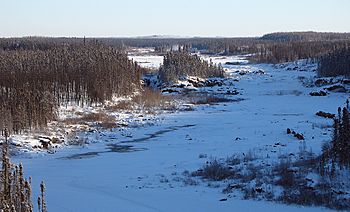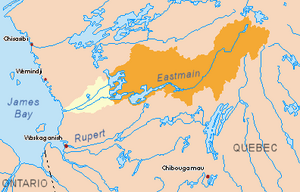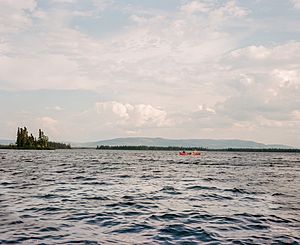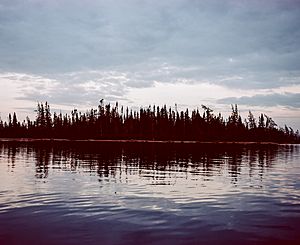Eastmain River facts for kids
Quick facts for kids Eastmain |
|
|---|---|

Eastmain River in Dec. 2005 at the James Bay Road.
|
|

Eastmain River original basin in yellow and orange. Diverted basin in orange.
|
|
| Country | Canada |
| Province | Quebec |
| Region | Jamésie |
| Physical characteristics | |
| Main source | Lac Bréhat Baie-James, Nord-du-Québec, Québec, Canada 554 m (1,818 ft) 52°31′30″N 70°52′00″W / 52.52500°N 70.86667°W |
| River mouth | James Bay Eastmain, Nord-du-Québec, Quebec, Canada 0 m (0 ft) 52°14′30″N 78°34′00″W / 52.24167°N 78.56667°W |
| Length | 756 km (470 mi) |
| Basin features | |
| Basin size | 46,400 km2 (17,900 sq mi) |
| Tributaries |
|
The Eastmain River, formerly written East Main, is a river in west central Quebec. It rises in central Quebec and flows 800 km (500 mi) west to James Bay, draining an area of 46,400 km2 (17,900 sq mi). The First Nations Cree village of Eastmain is located beside the mouth.
Name
Eastmain is a compounding of the river's former name East Main, taken from the former Hudson's Bay Company outpost at its mouth, which controlled the HBC's operations in the East Main District on the eastern side of James Bay.
Geography
Since the late 1980s, most of the waters of the Eastmain River have been diverted and flow northwards through the Opinaca Reservoir, with a surface area of about 950 km2, and into the Robert-Bourassa Reservoir of Hydro-Québec's La Grande Complex. The remainder of the Eastmain River contains only about 10% of the volume of its former flow, and is now subject to freeze-up in winter (see photo). These changes have affected the Cree and Inuit peoples who live along the Eastmain River and James Bay coast.
A further hydroelectric project on the upper Eastmain River was under construction in 2005. The project was part of the original hydroelectric project provided for by the James Bay and Northern Quebec Agreement of 1975. The Eastmain Reservoir will eventually have a surface area of about 600 km2 and the Eastmain-1 power plant will generate a maximum of 900 MW.
History
The mouth of the Eastmain was a centre of the Hudson Bay Company fur trade. Charles Bayly reached it from Rupert House in the 1670s. After Rupert House was destroyed in 1686, the area was visited by a ship from York Factory. In 1723-24 Joseph Myatt of the Hudson's Bay Company built a post.
See also
 In Spanish: Río Eastmain para niños
In Spanish: Río Eastmain para niños



